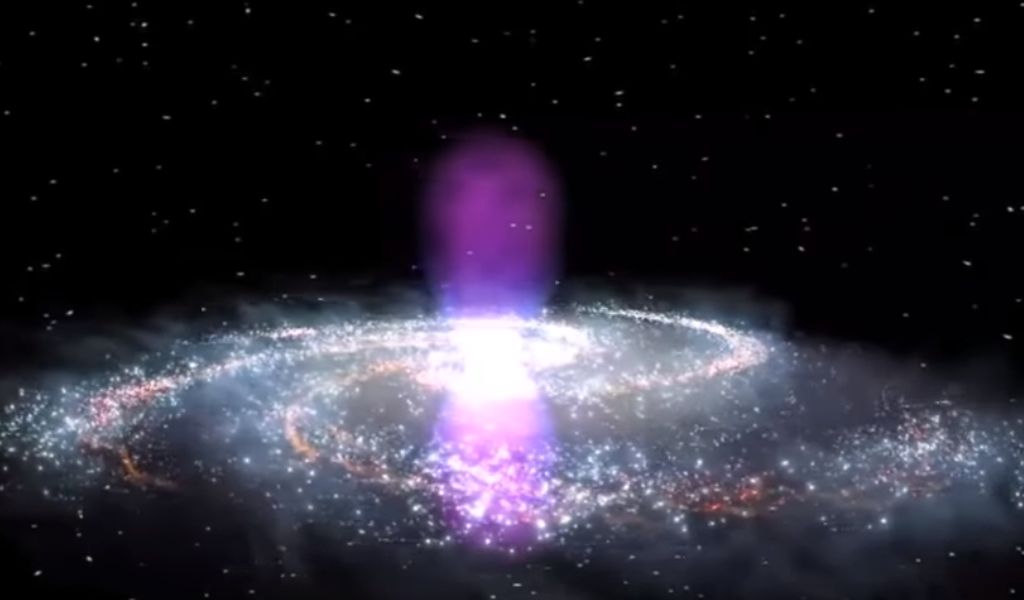A group of astronomers from all over the world has found hundreds of strange shapes in the middle of the Milky Way galaxy.
A study published Friday in The Astrophysical Journal Letters says that these one-dimensional cosmic threads are made up of hundreds of horizontal or radial filaments. These filaments are thin, long bodies of glowing gas that may have formed a few million years ago when outflow from Sagittarius A*, the Milky Way’s central supermassive black hole, interacted with materials in the area. Each thread is between 5 and 10 light-years long, which isn’t very long.
About 40 years ago, the study’s lead author, Farhad Yusef-Zadeh, and other scientists found another group of nearly 1,000 one-dimensional filaments near the center of the galaxy. These filaments are vertical and much longer, measuring up to 150 light-years each. In 2022, Yusef-Zadeh and his colleagues found hundreds more paired and grouped vertical filaments in the same area. They realized that the filaments were probably caused by activity around Sagittarius A*, not by supernova explosions as they had thought before. The new study backs up and adds to what was already known.
Yusef-Zadeh, a professor of physics and astronomy at Northwestern University’s Weinberg College of Arts and Sciences, said in a news release that finding a “new population of structures that seem to be pointing in the direction of the black hole” was a surprise.
“When I saw these, I was actually shocked. We had to do a lot of work to prove that we weren’t fooling ourselves,” said Yusef-Zadeh, who is also a part of the Center for Interdisciplinary Exploration and Research in Astrophysics. “We found that these filaments are not random, but instead seem to be linked to the flow of matter away from our black hole.” It’s satisfying to find order in the chaos of the center of our galaxy.”
Erika Hamden, an assistant professor of astronomy at the University of Arizona who wasn’t part of the study, said the results about the black hole about 26,000 light-years from Earth are “really exciting” and “show how beautiful the universe is.”
“Sagittarius A* is the supermassive black hole that is closest to us, but it’s pretty quiet, so it’s hard to really study it,” Hamden said. “But this work shows that it was recently sending out a jet and a cone-shaped flow of energy into space.”
Learning More about the Milky Way
The South African Radio Astronomy Observatory’s MeerKAT telescope, which has 64 satellite dishes that are each 65 feet (nearly 20 meters) tall and connected over 5 miles (roughly 8 kilometers) of a sparsely populated area with little interference, produced images that the researchers used to identify the structures.
According to Yusef-Zadeh, “the new MeerKAT observations have changed the game.” It’s really a technological triumph for radio astronomers, in my opinion.
The authors of the present study disagree that the populations exhibit exactly the same qualities despite the similarities between the recently discovered filaments and those reported in 1984.
According to the press release, the horizontal filaments are parallel to the galactic plane and point radially toward the black hole, whilst the vertical filaments are situated perpendicular to the galactic plane. The Milky Way’s nucleus is surrounded by vertical filaments, but it appears that the horizontal filaments are spreading out in the direction of the black hole.
“The distribution and alignment of the filaments can help show how the material has moved and distorted in the past,” added Hamden.
The horizontal filaments emit thermal radiation and material linked to molecular clouds that are partially or entirely immersed in the outflow from the black hole, according to the authors. Their behaviors also diverge. Gas, dust, and stars make up molecular clouds. On the other hand, the vertical filaments are magnetic and contain cosmic ray electrons traveling almost as quickly as light.
More research into the newly discovered filaments, according to the scientists, could teach them more about the black hole’s spin and accretion disk orientation, Yusef-Zadeh added.
The thin, hot structure that develops around a black hole as matter from a neighboring star is drawn in a circle is known as the accretion disk.
Hamden said that further research is required to ascertain whether the jet-driven outflow from the black hole, and therefore more filaments, occur on both sides of the black hole. A beam of material expelled from some celestial objects is referred to as a jet in this context.
There should be a pair since black holes “typically eject jets symmetrically,” continued Hamden. Finding both sides of the (filament) structure is one approach to prove that it was produced by a jet, for example.
This would “to the complex, active picture of our own Milky Way,” she said.
According to Yusef-Zadeh, their work is “never complete.”
We constantly need to make new observations, test our assumptions, and improve our analyses, he continued.






































